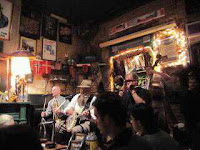So Where Does The Banjo Come In?
 |
| Jazz In New Orleans |
The musicians job is to create a drama for the audience. The musician tells a story that draws the audience into an experience that is beyond ordinary, day to day life.
Obviously the musician must know his instrument. Scales, chords, loud, soft, timbre, articulation..., all of those are necessary. But musicianship goes beyond simple mastery of an instrument. One does not approach "musicianship" until they begin to approach music as a dramatic structure. A horn player just plays notes - a "musician" tells a story.
The first step to understanding the dramatic structure of a piece is to decide what is important to the drama and what is not. In gestalt terms, the musician must know what is figure and what is ground.
Of course there are stages of musical development. In jazz, the first stage is usually, "Oh my, what notes do I play?". You hear many jazz musicians in this stage. Some get very good at playing lot's of notes, or "licks". Then they go into the, "Hey, listen to me stage" (many banjo players seem to get stuck in the stage). Mature players know that what they do not play is just as important as what they do play. It works like this: if a figure is constantly prominent, then it becomes the ground. When there is no ground, the figures loose the attention of the audience. They become nothing more than a new ground.
In a jazz ensemble where all of the musicians are improvising, it is very important that each player understands exactly what his task is. In a typical dixieland band playing a full ensemble passage, the cornet or trumpet is playing the figure, the clarinet is playing a subservient figure that harmonizes and elides the cornet player's phrases. The trombone is furnishing a "tailgate" counter melody and works with the clarinet to elide the phrase. The bass is furnishing the rhythmic pulse and harmonic foundation. These are the instruments that have a roll in the figure of the piece. The most important voices are the cornet and bass. Clarinet and trombone, though still in the figure, are secondary to the cornet and bass.
The rest of the instruments are normally furnishing the ground that sets off the figure. The drums define the rhythmic flavor. The piano and banjo (if present in the ensemble) fill in the harmonic structure outlined by the bass. In a well balanced ensemble, the drums are seen but seldom heard. The piano/guitar/banjo part is basically non-essential during a full ensemble. They subtly reinforce the rhythmic flavor that the drummer defines. Like the drum part, the banjo/piano are normally part of the ground and should be felt more than heard.
Comments
Post a Comment